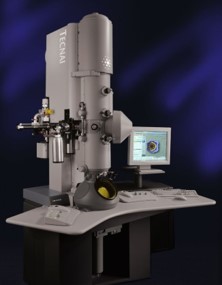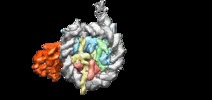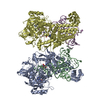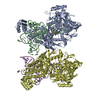[English] 日本語
 Yorodumi
Yorodumi- EMDB-9355: Cryo-EM structure of singly-bound SNF2h-nucleosome complex at 6.9... -
+ Open data
Open data
- Basic information
Basic information
| Entry | Database: EMDB / ID: EMD-9355 | |||||||||||||||
|---|---|---|---|---|---|---|---|---|---|---|---|---|---|---|---|---|
| Title | Cryo-EM structure of singly-bound SNF2h-nucleosome complex at 6.9A with SNF2h bound at SHL+2 | |||||||||||||||
 Map data Map data | Final map, mildly sharpened, resampled to fit with other maps | |||||||||||||||
 Sample Sample |
| |||||||||||||||
| Biological species | ||||||||||||||||
| Method | single particle reconstruction / cryo EM / Resolution: 6.9 Å | |||||||||||||||
 Authors Authors | Armache J-P / Gamarra N / Johnson SL / Wu S / Leonard JD / Narlikar GJ / Cheng Y | |||||||||||||||
| Funding support |  United States, 4 items United States, 4 items
| |||||||||||||||
 Citation Citation |  Journal: Elife / Year: 2019 Journal: Elife / Year: 2019Title: Cryo-EM structures of remodeler-nucleosome intermediates suggest allosteric control through the nucleosome. Authors: Jean Paul Armache / Nathan Gamarra / Stephanie L Johnson / John D Leonard / Shenping Wu / Geeta J Narlikar / Yifan Cheng /  Abstract: The SNF2h remodeler slides nucleosomes most efficiently as a dimer, yet how the two protomers avoid a tug-of-war is unclear. Furthermore, SNF2h couples histone octamer deformation to nucleosome ...The SNF2h remodeler slides nucleosomes most efficiently as a dimer, yet how the two protomers avoid a tug-of-war is unclear. Furthermore, SNF2h couples histone octamer deformation to nucleosome sliding, but the underlying structural basis remains unknown. Here we present cryo-EM structures of SNF2h-nucleosome complexes with ADP-BeF that capture two potential reaction intermediates. In one structure, histone residues near the dyad and in the H2A-H2B acidic patch, distal to the active SNF2h protomer, appear disordered. The disordered acidic patch is expected to inhibit the second SNF2h protomer, while disorder near the dyad is expected to promote DNA translocation. The other structure doesn't show octamer deformation, but surprisingly shows a 2 bp translocation. FRET studies indicate that ADP-BeF predisposes SNF2h-nucleosome complexes for an elemental translocation step. We propose a model for allosteric control through the nucleosome, where one SNF2h protomer promotes asymmetric octamer deformation to inhibit the second protomer, while stimulating directional DNA translocation. | |||||||||||||||
| History |
|
- Structure visualization
Structure visualization
| Movie |
 Movie viewer Movie viewer |
|---|---|
| Structure viewer | EM map:  SurfView SurfView Molmil Molmil Jmol/JSmol Jmol/JSmol |
| Supplemental images |
- Downloads & links
Downloads & links
-EMDB archive
| Map data |  emd_9355.map.gz emd_9355.map.gz | 59 MB |  EMDB map data format EMDB map data format | |
|---|---|---|---|---|
| Header (meta data) |  emd-9355-v30.xml emd-9355-v30.xml emd-9355.xml emd-9355.xml | 17.8 KB 17.8 KB | Display Display |  EMDB header EMDB header |
| Images |  emd_9355.png emd_9355.png | 204.3 KB | ||
| Others |  emd_9355_additional.map.gz emd_9355_additional.map.gz emd_9355_half_map_1.map.gz emd_9355_half_map_1.map.gz emd_9355_half_map_2.map.gz emd_9355_half_map_2.map.gz | 31.7 MB 59.3 MB 59.3 MB | ||
| Archive directory |  http://ftp.pdbj.org/pub/emdb/structures/EMD-9355 http://ftp.pdbj.org/pub/emdb/structures/EMD-9355 ftp://ftp.pdbj.org/pub/emdb/structures/EMD-9355 ftp://ftp.pdbj.org/pub/emdb/structures/EMD-9355 | HTTPS FTP |
-Validation report
| Summary document |  emd_9355_validation.pdf.gz emd_9355_validation.pdf.gz | 79.1 KB | Display |  EMDB validaton report EMDB validaton report |
|---|---|---|---|---|
| Full document |  emd_9355_full_validation.pdf.gz emd_9355_full_validation.pdf.gz | 78.2 KB | Display | |
| Data in XML |  emd_9355_validation.xml.gz emd_9355_validation.xml.gz | 494 B | Display | |
| Arichive directory |  https://ftp.pdbj.org/pub/emdb/validation_reports/EMD-9355 https://ftp.pdbj.org/pub/emdb/validation_reports/EMD-9355 ftp://ftp.pdbj.org/pub/emdb/validation_reports/EMD-9355 ftp://ftp.pdbj.org/pub/emdb/validation_reports/EMD-9355 | HTTPS FTP |
-Related structure data
| Related structure data |  9351C  9352C  9353C  9354C  9356C  6ne3C C: citing same article ( |
|---|---|
| Similar structure data |
- Links
Links
| EMDB pages |  EMDB (EBI/PDBe) / EMDB (EBI/PDBe) /  EMDataResource EMDataResource |
|---|
- Map
Map
| File |  Download / File: emd_9355.map.gz / Format: CCP4 / Size: 64 MB / Type: IMAGE STORED AS FLOATING POINT NUMBER (4 BYTES) Download / File: emd_9355.map.gz / Format: CCP4 / Size: 64 MB / Type: IMAGE STORED AS FLOATING POINT NUMBER (4 BYTES) | ||||||||||||||||||||||||||||||||||||||||||||||||||||||||||||||||||||
|---|---|---|---|---|---|---|---|---|---|---|---|---|---|---|---|---|---|---|---|---|---|---|---|---|---|---|---|---|---|---|---|---|---|---|---|---|---|---|---|---|---|---|---|---|---|---|---|---|---|---|---|---|---|---|---|---|---|---|---|---|---|---|---|---|---|---|---|---|---|
| Annotation | Final map, mildly sharpened, resampled to fit with other maps | ||||||||||||||||||||||||||||||||||||||||||||||||||||||||||||||||||||
| Projections & slices | Image control
Images are generated by Spider. | ||||||||||||||||||||||||||||||||||||||||||||||||||||||||||||||||||||
| Voxel size | X=Y=Z: 1.2156 Å | ||||||||||||||||||||||||||||||||||||||||||||||||||||||||||||||||||||
| Density |
| ||||||||||||||||||||||||||||||||||||||||||||||||||||||||||||||||||||
| Symmetry | Space group: 1 | ||||||||||||||||||||||||||||||||||||||||||||||||||||||||||||||||||||
| Details | EMDB XML:
CCP4 map header:
| ||||||||||||||||||||||||||||||||||||||||||||||||||||||||||||||||||||
-Supplemental data
-Additional map: Final map, unsharpened
| File | emd_9355_additional.map | ||||||||||||
|---|---|---|---|---|---|---|---|---|---|---|---|---|---|
| Annotation | Final map, unsharpened | ||||||||||||
| Projections & Slices |
| ||||||||||||
| Density Histograms |
-Half map: Half map1
| File | emd_9355_half_map_1.map | ||||||||||||
|---|---|---|---|---|---|---|---|---|---|---|---|---|---|
| Annotation | Half map1 | ||||||||||||
| Projections & Slices |
| ||||||||||||
| Density Histograms |
-Half map: Half map2
| File | emd_9355_half_map_2.map | ||||||||||||
|---|---|---|---|---|---|---|---|---|---|---|---|---|---|
| Annotation | Half map2 | ||||||||||||
| Projections & Slices |
| ||||||||||||
| Density Histograms |
- Sample components
Sample components
-Entire : Cryo-EM structure of singly-bound SNF2h-nucleosome complex at 6.9...
| Entire | Name: Cryo-EM structure of singly-bound SNF2h-nucleosome complex at 6.9A with SNF2h bound at SHL+2 |
|---|---|
| Components |
|
-Supramolecule #1: Cryo-EM structure of singly-bound SNF2h-nucleosome complex at 6.9...
| Supramolecule | Name: Cryo-EM structure of singly-bound SNF2h-nucleosome complex at 6.9A with SNF2h bound at SHL+2 type: complex / ID: 1 / Parent: 0 |
|---|---|
| Source (natural) | Organism: |
| Recombinant expression | Organism:  |
| Molecular weight | Theoretical: 340 kDa/nm |
-Experimental details
-Structure determination
| Method | cryo EM |
|---|---|
 Processing Processing | single particle reconstruction |
| Aggregation state | particle |
- Sample preparation
Sample preparation
| Buffer | pH: 7.5 |
|---|---|
| Grid | Model: Quantifoil R1.2/1.3 / Material: COPPER / Mesh: 400 |
| Vitrification | Cryogen name: ETHANE / Chamber humidity: 100 % / Chamber temperature: 295.15 K / Instrument: FEI VITROBOT MARK I Details: 2.5 ul of nucleosome-443 SNF2h complexes were applied to a glow discharged Quantifoil holey carbon grid (1.2 um hole size, 400 mesh), blotted in a Vitrobot Mark I (FEI Company) using 6 ...Details: 2.5 ul of nucleosome-443 SNF2h complexes were applied to a glow discharged Quantifoil holey carbon grid (1.2 um hole size, 400 mesh), blotted in a Vitrobot Mark I (FEI Company) using 6 seconds blotting at 100% humidity, and then plunge-frozen in liquid ethane cooled by liquid nitrogen.. |
| Details | This sample was monodisperse |
- Electron microscopy
Electron microscopy
| Microscope | FEI POLARA 300 |
|---|---|
| Image recording | Film or detector model: GATAN K2 SUMMIT (4k x 4k) / Detector mode: SUPER-RESOLUTION / Average electron dose: 41.0 e/Å2 |
| Electron beam | Acceleration voltage: 300 kV / Electron source:  FIELD EMISSION GUN FIELD EMISSION GUN |
| Electron optics | Illumination mode: FLOOD BEAM / Imaging mode: BRIGHT FIELD |
| Experimental equipment |  Model: Tecnai Polara / Image courtesy: FEI Company |
+ Image processing
Image processing
-Atomic model buiding 1
| Refinement | Space: REAL / Protocol: RIGID BODY FIT |
|---|
 Movie
Movie Controller
Controller









 Z (Sec.)
Z (Sec.) Y (Row.)
Y (Row.) X (Col.)
X (Col.)













































